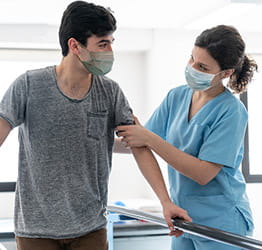What Is a Corneal Transplant?
A corneal transplant is a procedure to replace an injured or diseased cornea, the clear and outer layer of the eye. The cornea protects your eye from dirt and germs, and its curved edge refracts light, helping the eye focus.
A corneal transplant replaces just the outer layer of the eye, not the whole eye. Sometimes, the remaining tissue is used for research or educational purposes.
Because there's currently no manmade substitute for a real human cornea, donated corneas are critical to enabling the procedure.
Receiving a corneal transplant can mean receiving the gift of sight. Some people see great improvement in a few weeks, while others may have to wait up to a year for their vision to improve. The donated tissue usually lasts a lifetime.
How common are corneal transplants?
Corneal transplants are the most common type of transplant surgery done in the U.S.
According to the Eye Bank Association of America (EBAA), in 2023, U.S. eye banks recorded 137,697 tissue recoveries from 69,637 total donors. Of those donors, 63.4% were listed on a donor registry. Donation levels were up 12.8% compared to 2022, which is close to pre-Covid levels..
What are the types of corneal transplants?
There are two types of corneal transplants:
- Penetrating keratoplasty (full-thickness corneal transplant) — Replaces the entire cornea after scarring or damage.
- Lamellar keratoplasty (partial-thickness corneal transplant) — Replaces part of the cornea.
Why Would I Need a Corneal Transplant?
If you injure your cornea, you might need a cornea transplant to replace the damaged cornea.
In addition, some genetic problems of the cornea, such as Fuch’s dystrophy or keratoconus, can lead to distorted, cloudy, or reduced vision and, in rare cases, blindness. When a diseased cornea can't be treated with corrective lenses or medications, surgery may be necessary.
Who is a candidate for a corneal transplant?
Your ophthalmologist can determine if you're a candidate for a corneal transplant.
During a comprehensive eye exam, your eye doctor will assess the condition of your cornea. To detect corneal abrasions (scratches), they may administer fluorescein dye eye drops, which enhance visibility.
What Are the Risks and Complications of a Corneal Transplant?
Corneal transplant risk factors
While some corneal conditions, such as corneal dystrophies, are hereditary, you can take steps to reduce your risk of corneal injuries and infections.
To prevent corneal injuries, wear protective eyewear when:
- Doing yard work — Such as mowing the lawn or using a weedwhacker.
- Handling chemicals — Such as bleach or pesticides.
- Performing repairs — Like painting or hammering.
- Playing sports involving balls or pucks — Like baseball, pickleball, or hockey.
- Using machinery — Like sanders or drills.
In addition, if you wear contact lenses, always follow the instructions for cleaning, disinfecting, and storing your lenses. This practice can help prevent corneal infections, including keratitis.
Complications of a corneal transplant
Like any surgical procedure, corneal transplant surgery carries risks. One significant risk is tissue rejection, where your body perceives the new cornea as foreign and attempts to eliminate it. Your doctor can prescribe medication to prevent rejection and safeguard your cornea.
Corneal transplant surgery may also lead to other eye issues, such as:
If you experience tissue rejection or encounter severe problems with the transplanted cornea, further transplantation may be necessary. It’s important to discuss the risks associated with a corneal transplant with your doctor to determine if this treatment is right for you.
What Should I Expect From a Corneal Transplant?
Before — How to prepare for a corneal transplant
Before your doctor schedules your corneal transplant, they will conduct an extensive eye exam.
Tell your doctor what prescription and over-the-counter (OTC) medications, herbs, and supplements you take and what health issues you have. Also, tell your doctor about any allergies you have, especially to medications or latex.
Some medications, such as aspirin, ibuprofen (Advil, MOTRIN®), and warfarin (COUMADIN®), might need to be stopped a week to 10 days before surgery. Your provider will tell you which medications to stop prior to surgery and which you may continue to take up to and on the morning of your surgery.
A nurse or scheduler will call you before your surgery to give you specific instructions for eating and drinking and other guidelines for the day of your surgery.
Generally, these instructions include:
- Arranging a ride home after the surgery, as you can't drive home yourself.
- Arriving for surgery without makeup, creams, lotions, or jewelry on your face.
- Stopping eating and drinking after midnight on the night before surgery.
- Wearing comfortable clothing on the day of surgery.
How long does a corneal transplant take?
The surgery itself takes about 1 to 3 hours.
During your corneal transplant
A cornea transplant can be done while you're under general anesthesia or while you’re awake. If you're awake for the surgery, you'll be given numbing eye drops and other medications to help you relax.
The surgeon will use a special tool to prop your eye open during surgery. The damaged part of the cornea will be removed and replaced with healthy donor tissue.
Recovery after a corneal transplant
A corneal transplant is an outpatient procedure that allows you to return home on the same day.
A follow-up appointment is necessary the day after the procedure to ensure your eye is healing properly.
Follow these steps for optimal recovery:
- Avoid rubbing or applying pressure to your eye.
- Consider wearing eyeglasses or a protective shield to safeguard your eyes.
- Use the specific eye drops prescribed by your doctor.
The complete recovery period can vary and may last up to a year, depending on the type of transplant.
When to call your doctor about corneal transplant post-op problems
After corneal transplant, go to the eye doctor or emergency department if you have:
- An injury or trauma to the eye.
- Blurred vision.
- Severe eye pain.
- Something stuck in your eye.
- Vision changes.
- Very red, watery eyes.
What are the results of corneal transplants?
Corneal transplant surgery has a high success rate. More than 95% of corneal transplant operations restore the recipient’s vision.
How Can I Become a Cornea Donor?
Any adult can become a corneal transplant donor unless they have a highly communicable disease like HIV or hepatitis. You don’t have to have a certain blood type, and people of all genders, ages, and races can donate. It also doesn’t matter what color your eyes are or even how good your own eyesight is.
If you have a faith leader, you may want to ask them for reassurance before registering as an organ donor. However, organ donation — including donating eyes — is supported by the teachings of all the major religions, according to the Eye Bank Association of America (EBAA). It’s also important to discuss your wishes with close family members.
For a successful transplant, donor corneas must be recovered within a few hours of the donor’s death. Most transplants occur within a week after donor recovery, according to the EBAA.
If you’ve signed a donor card, registered online, or even marked “organ donor” on your driver’s license, you'll be considered a donor when the time comes. Registered organ donors also agree to donate their tissue and corneas.
To become a cornea donor, you can register on the U.S. government’s national organ donor website or with the EBAA. You can also register as an organ, eye, and tissue donor online. Organ donors have the potential to save up to eight lives and enhance the lives of 75 others, including giving the gift of sight.
Why Choose UPMC for Corneal Transplant Care?
The UPMC Vision Institute uses advanced surgical techniques to restore people’s visual clarity and enhance their quality of life.
Thanks to minimally invasive surgical techniques, corneal transplant surgery can be performed as a same-day, outpatient procedure. For most people, minimally invasive surgeries typically mean smaller incisions, less bleeding, fewer infections, and faster recovery times.
By UPMC Editorial Staff. Last reviewed on 2025-01-15 by Vishal Jhanji, MD.
















